微软与VMWARE的桌面虚拟化简介
VMware服务器虚拟化与桌面虚拟化
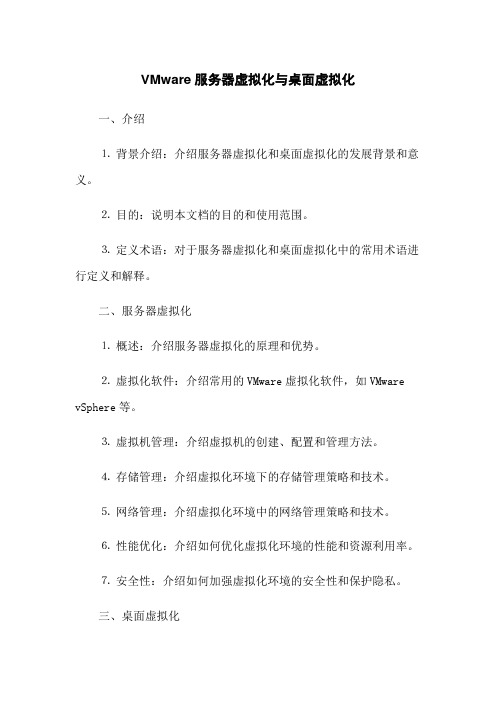
VMware服务器虚拟化与桌面虚拟化
一、介绍
⒈背景介绍:介绍服务器虚拟化和桌面虚拟化的发展背景和意义。
⒉目的:说明本文档的目的和使用范围。
⒊定义术语:对于服务器虚拟化和桌面虚拟化中的常用术语进行定义和解释。
二、服务器虚拟化
⒈概述:介绍服务器虚拟化的原理和优势。
⒉虚拟化软件:介绍常用的VMware虚拟化软件,如VMware vSphere等。
⒊虚拟机管理:介绍虚拟机的创建、配置和管理方法。
⒋存储管理:介绍虚拟化环境下的存储管理策略和技术。
⒌网络管理:介绍虚拟化环境中的网络管理策略和技术。
⒍性能优化:介绍如何优化虚拟化环境的性能和资源利用率。
⒎安全性:介绍如何加强虚拟化环境的安全性和保护隐私。
三、桌面虚拟化
⒈概述:介绍桌面虚拟化的原理和优势。
⒉虚拟桌面基础设施(VDI):介绍VDI架构和实施步骤。
⒊桌面部署:介绍如何部署和管理虚拟桌面环境。
⒋用户体验管理:介绍如何提供良好的用户体验和性能。
⒌安全性:介绍如何加强虚拟桌面环境的安全性和保护隐私。
⒍桌面备份和恢复:介绍如何进行桌面虚拟化环境的备份和恢复。
⒎性能优化:介绍如何优化桌面虚拟化环境的性能和资源利用率。
四、附件
⒉附件2:服务器虚拟化的操作手册。
⒋附件4:桌面虚拟化的操作手册。
注释:
⒈服务器虚拟化:将一台物理服务器分割成多个虚拟服务器的技术。
⒉桌面虚拟化:将用户的桌面环境虚拟化在服务器上,用户通过终端访问虚拟桌面。
⒊ VMware vSphere:一套基于服务器虚拟化的云计算平台。
微软虚拟化概述

微软虚拟化概述及优势概述一整套方案: 从数据中心到桌面。
在微软,虚拟化意味着帮助 IT 部门最大程度地节约成本并提高业务连续性。
我们的解决方案同时在物理和虚拟基础结构中,并且可以通过一个工作台轻松地加以管理。
在熟悉的平台上获取伙伴的支持微软虚拟化解决方案基于熟悉的 Windows 界面,使用熟悉的 Windows 技术操作。
基于 Windows 的解决方案可以使您得到很多经验丰富的合作伙伴的支持,他们可以快速对业务需求做出反应。
了解熟悉的平台如何帮助您降低成本。
降低总体拥有成本/最大化投资回报比起使用其他同类产品,在 Windows Server 与 System Center 中安装Hyper-V,使用微软技术虚拟化技术,企业可以降低成本,从而帮助您的虚拟化投资得到最大程度的回报。
了解虚拟化如何节省您的资金。
对物理与虚拟设备进行无缝管理微软虚拟化技术使您能优化资产,跨多个管理程序(直到应用程序级别)集中管理所有物理和虚拟资源。
了解虚拟化如何帮助您管理物理和虚拟资产。
互操作工具微软虚拟化产品可以与 IT 员工熟悉和正在使用的工具无缝集成,支持整个企业的全面整合。
了解虚拟化如何增强您现有的工具。
应用技能集更轻松的部署和支持意味着更少的培训和成本。
微软虚拟化解决方案构建于员工已经熟悉的平台上,因此您需要的培训更少,公司的成本也会降低。
Dartmouth-Hitchcock 医疗中心“我们希望使用 Hyper-V 整合另外 75 台服务器,这样每年将节省 325000 多美元。
”Robert McShinksy,Dartmouth-Hitchcock 医疗中心高级管理员Dartmouth-Hitchcock 医疗中心 (DHMC) 位于新罕布什尔州 (New Hampshire),三年前开始使用服务器虚拟化来抑制服务器增多和不断上升的电费开支。
DHMC 决定使用 Hyper-V 技术和 Microsoft System Center Virtual Machine Manager 2008 将它的虚拟化基础结构移植到 Windows Server 2008 操作系统,他们期望减少 75%的主机,并从每台服务器的硬件、维护、电力和占地的总花费中节省 4,300 美元。
桌面虚拟化解决方案

桌面虚拟化解决方案简介桌面虚拟化是一种通过将用户的操作系统和应用程序从物理计算机转移到虚拟机的技术,使用户可以在任何地方和任何设备上访问他们的桌面。
这种解决方案提供了许多优势,包括更高的灵活性、更好的安全性和更低的维护成本。
本文将介绍桌面虚拟化的定义、优势以及一些常见的桌面虚拟化解决方案。
桌面虚拟化的优势灵活性桌面虚拟化解决方案使用户可以从任何设备上访问他们的桌面,无论是台式机、笔记本电脑还是移动设备。
这意味着用户可以通过他们喜欢的设备工作,无论是在办公室、家里还是外出旅行。
这种灵活性给予用户更多的选择,提高了工作效率和生产力。
安全性传统的桌面环境通常存储在本地计算机中,容易受到病毒、恶意软件和数据泄露等安全威胁的攻击。
而桌面虚拟化解决方案将桌面数据存储在数据中心或云服务器中,通过安全的网络连接将桌面传输到用户设备。
这样一来,即使用户设备受到攻击,也不会导致重要数据的泄露或损失。
管理和维护便捷在传统的桌面环境中,IT管理员需要逐个维护每台计算机的操作系统和应用程序,并解决用户的各种问题。
而桌面虚拟化解决方案可以集中管理和维护所有虚拟桌面,通过统一的管理界面进行操作,大大简化了管理工作。
管理员可以轻松地对桌面环境进行升级和更新,而用户只需通过简单的连接就能享受到最新的桌面功能和应用程序。
桌面虚拟化解决方案VMware HorizonVMware Horizon是一种领先的桌面虚拟化解决方案,提供了卓越的用户体验和丰富的功能。
它使用VMware的虚拟化技术将用户的桌面和应用程序虚拟化,并通过网络传输到用户设备。
VMware Horizon支持各种设备和操作系统,包括Windows、Mac、Linux、iOS和Android。
它还提供了丰富的管理工具,使管理员能够轻松管理和维护虚拟桌面环境。
Citrix Virtual Apps and DesktopsCitrix Virtual Apps and Desktops是另一种受欢迎的桌面虚拟化解决方案,提供了高度灵活和安全的桌面体验。
微软桌面虚拟化解决方案
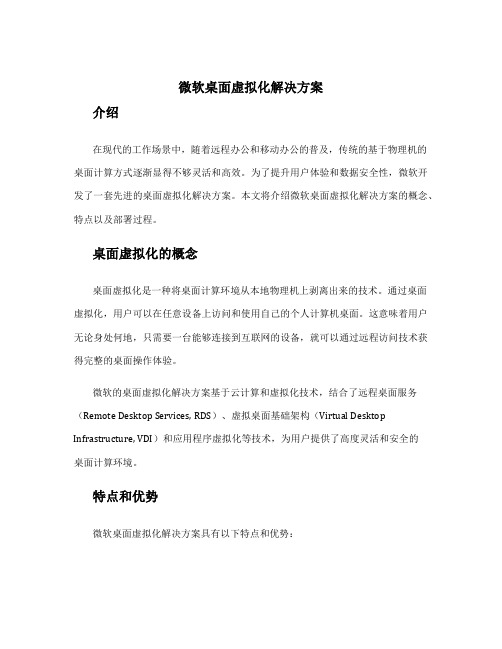
微软桌面虚拟化解决方案介绍在现代的工作场景中,随着远程办公和移动办公的普及,传统的基于物理机的桌面计算方式逐渐显得不够灵活和高效。
为了提升用户体验和数据安全性,微软开发了一套先进的桌面虚拟化解决方案。
本文将介绍微软桌面虚拟化解决方案的概念、特点以及部署过程。
桌面虚拟化的概念桌面虚拟化是一种将桌面计算环境从本地物理机上剥离出来的技术。
通过桌面虚拟化,用户可以在任意设备上访问和使用自己的个人计算机桌面。
这意味着用户无论身处何地,只需要一台能够连接到互联网的设备,就可以通过远程访问技术获得完整的桌面操作体验。
微软的桌面虚拟化解决方案基于云计算和虚拟化技术,结合了远程桌面服务(Remote Desktop Services, RDS)、虚拟桌面基础架构(Virtual Desktop Infrastructure, VDI)和应用程序虚拟化等技术,为用户提供了高度灵活和安全的桌面计算环境。
特点和优势微软桌面虚拟化解决方案具有以下特点和优势:1. 灵活性和可扩展性微软的桌面虚拟化解决方案可以根据实际需求进行灵活部署和扩展。
通过虚拟化技术,管理员可以轻松地创建和管理大量的虚拟桌面,根据用户的工作负载进行优化和调整。
这使得企业可以根据实际需求灵活地分配资源,提高整体效率和灵活性。
2. 高度集成和统一管理微软桌面虚拟化解决方案与Windows Server操作系统和Active Directory等微软基础设施紧密集成,提供了统一的管理界面和管理工具。
管理员可以通过集中管理平台轻松地管理用户、桌面、应用程序和权限等。
这简化了管理工作,并减少了管理成本和复杂性。
3. 安全性和数据保护微软桌面虚拟化解决方案通过将桌面计算环境从本地物理机上转移到数据中心,提供了更高的安全性和数据保护。
数据存储在安全的数据中心中,用户可以通过安全的加密通道远程访问桌面。
此外,管理员可以通过集中管理和权限控制来保护数据和应用程序,确保敏感信息的安全性。
微软桌面虚拟化

13
管理桌面虚拟化 System Center 2012 Configuration Manager
微软桌面虚拟化
一、IT消费化趋势
任意地点工作
离线式工作
简化交付
2 合规性增强 业务连续性
统一管理化
用户状态
统一和集中化管理 应用程序
改变设备 保持原有体验
User Experience Virtualization (UE-V)
Folder Redirection
5
四、UE-V介绍
个人 & 灵活 简单& 通用 集成& 可伸缩
▪ 应用和操作系统的个性化设置可以在Windows间进行漫游 ▪ 同步更加敏捷登陆也更加快速 ▪ 应用程序或操作系统不需要在重新进行配置
▪ 模版自动识别设置位置 ▪ 自定义模版设置可以进行漫游的应用程序设置 ▪ 可以回滚到初始状态
▪ 使用已存在的工具部署更加简单 ▪ 可以使用组策略模版和Config Mgr 2012 DCM包 ▪ 无缝的与微软桌面虚拟化产品进行结合
操作系统 11
高效的管理
▪ 使用快速部署选项进行简单和快速的部署 ▪ 通过一个控制台接口对会话和虚拟机进行简单的管理 ▪ 简单智能的 VDI 补丁部署模式
最有出色价值 的虚拟桌面
▪ 使用Hyper-V技术提供高扩展并使用FairShare技术提供更高的系统性能 ▪ 使用用户配置文件磁盘部署低成本的桌面系统 ▪ 支持成本低廉的存储例如使用 SMB2 协议的共享文件夹中或直连式存储irtual Desktop Infrastructure (VDI)
9
灵活的访问Windows 使用自带的设备程序通过任意连接设备进行安全 地访问Windows
《微软虚拟化介绍》课件

Citrix XenServer
Citrix XenServer 是另一种流行的 虚拟化平台,具有强大的性能 和可扩展性。
KVM
KVM(Kernel-based Virtual Machine)是Linux内核中的虚拟 化模块,提供了开源的虚拟化 解决方案。
微软的虚拟化技术
Hyper-V
Hyper-V 是微软的主要虚拟化平台,具有强大的 架构、核心组件和虚拟处理器功能,广泛应用 于服务器虚拟化。
Virtual PC
Virtual PC 是微软提供的桌面虚拟化软件,具有 多种功能和应用场景,可以在个人电脑上运行 多个操作系统。
与其他虚拟化技术的比较
VMware vSphere
虚拟化的优势
1 硬件利用率的提升
通过虚拟化技术,可以将 一台物理服务器拆分为多 个虚拟机,最大限度地提 高硬件资源的利用效率。
2 系统资源的管理
3 应用程序的隔离
虚拟化技术提供了集中管 理虚拟机的工具,方便管 理员对系统资源进行监控、 配置和分配。
每个虚拟机都可以独立运 行不同的应用程序,相互 之间互不干扰,提供了更 高的安全性和稳定性。
微软虚拟化介绍
本PPT课件将带您了解微软的虚拟化技术,包括虚拟化的定义、优势以及与其 他虚拟化技术的比较,希望您将从中获得有关虚拟化的全面知识。
什么是虚拟化
定义虚拟化
虚拟化是一种将计算资源与软件应用程序从物理硬件中隔离的技术,使其能够在虚拟环境中 灵活运行。
原理与技术
虚拟化技术基于将物理资源(如处理器、内存和存储)抽象化,使其能够被多个虚拟机共享 和利用。
微软桌面虚拟化解决方案
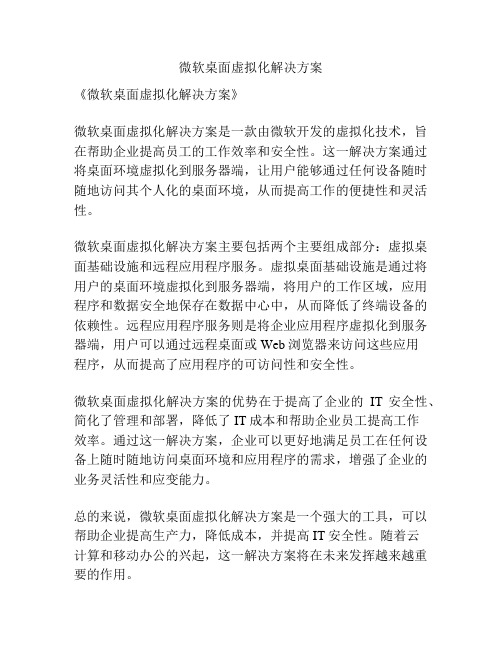
微软桌面虚拟化解决方案
《微软桌面虚拟化解决方案》
微软桌面虚拟化解决方案是一款由微软开发的虚拟化技术,旨在帮助企业提高员工的工作效率和安全性。
这一解决方案通过将桌面环境虚拟化到服务器端,让用户能够通过任何设备随时随地访问其个人化的桌面环境,从而提高工作的便捷性和灵活性。
微软桌面虚拟化解决方案主要包括两个主要组成部分:虚拟桌面基础设施和远程应用程序服务。
虚拟桌面基础设施是通过将用户的桌面环境虚拟化到服务器端,将用户的工作区域,应用程序和数据安全地保存在数据中心中,从而降低了终端设备的依赖性。
远程应用程序服务则是将企业应用程序虚拟化到服务器端,用户可以通过远程桌面或Web浏览器来访问这些应用
程序,从而提高了应用程序的可访问性和安全性。
微软桌面虚拟化解决方案的优势在于提高了企业的IT安全性、简化了管理和部署,降低了IT成本和帮助企业员工提高工作
效率。
通过这一解决方案,企业可以更好地满足员工在任何设备上随时随地访问桌面环境和应用程序的需求,增强了企业的业务灵活性和应变能力。
总的来说,微软桌面虚拟化解决方案是一个强大的工具,可以帮助企业提高生产力,降低成本,并提高IT安全性。
随着云
计算和移动办公的兴起,这一解决方案将在未来发挥越来越重要的作用。
(2024年)VMware虚拟化介绍PPT课件
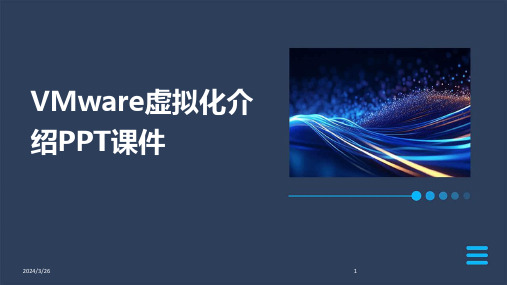
2024/3/26
23
备份恢复策略制定及执行
2024/3/26
备份策略
根据业务需求和数据重要性,制定合 适的备份策略,包括备份周期、备份 类型(如完全备份、增量备份等)和 备份存储位置等。
恢复策略
在虚拟机或数据损坏时,能够快速恢 复虚拟机或数据到备份状态,确保业 务连续性。同时,需要定期测试恢复 流程,确保其有效性。
感谢观看
2024/3/26
32
21
05
VMware虚拟化运维 管理策略
2024/3/26
22
性能监控与故障排查方法
性能监控
利用VMware提供的性能监控工具, 实时监控虚拟机、主机和存储的性能 指标,如CPU利用率、内存占用率、 磁盘I/O等。
故障排查
当出现故障时,通过查看日志文件、 诊断工具和资源监控信息,快速定位 并解决问题,确保虚拟化环境的稳定 运行。
2024/3/26
3
虚拟化定义与原理
2024/3/26
虚拟化定义
虚拟化是一种资源管理技术,将计算机的各种实体资源,如 服务器、网络、内存及存储等,予以抽象、转换后呈现出来 ,打破实体结构间的不可切割的障碍,使用户可以比原本的 组态更好的方式来应用这些资源。
虚拟化原理
虚拟化技术通过在物理服务器和操作系统之间加入一个虚拟 化层,将一台物理服务器分割成多个相互隔离的虚拟服务器 ,每个虚拟服务器都有自己的操作系统和应用程序,实现资 源的动态分配、灵活调度和高效管理。
VMware Site Recovery Manager
提供灾难恢复解决方案,确保业务在发生灾难时能够快速恢复。
VMware Horizon
提供虚拟桌面和应用解决方案,实现桌面和应用的集中管理和按需交 付。
桌面虚拟化方案
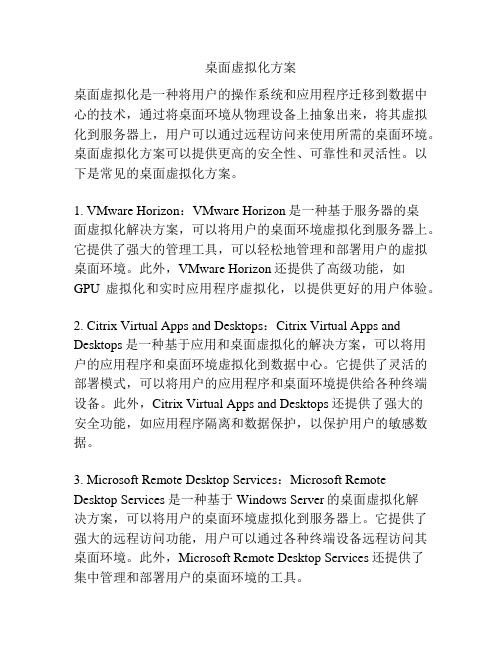
桌面虚拟化方案桌面虚拟化是一种将用户的操作系统和应用程序迁移到数据中心的技术,通过将桌面环境从物理设备上抽象出来,将其虚拟化到服务器上,用户可以通过远程访问来使用所需的桌面环境。
桌面虚拟化方案可以提供更高的安全性、可靠性和灵活性。
以下是常见的桌面虚拟化方案。
1. VMware Horizon:VMware Horizon是一种基于服务器的桌面虚拟化解决方案,可以将用户的桌面环境虚拟化到服务器上。
它提供了强大的管理工具,可以轻松地管理和部署用户的虚拟桌面环境。
此外,VMware Horizon还提供了高级功能,如GPU虚拟化和实时应用程序虚拟化,以提供更好的用户体验。
2. Citrix Virtual Apps and Desktops:Citrix Virtual Apps and Desktops是一种基于应用和桌面虚拟化的解决方案,可以将用户的应用程序和桌面环境虚拟化到数据中心。
它提供了灵活的部署模式,可以将用户的应用程序和桌面环境提供给各种终端设备。
此外,Citrix Virtual Apps and Desktops还提供了强大的安全功能,如应用程序隔离和数据保护,以保护用户的敏感数据。
3. Microsoft Remote Desktop Services:Microsoft Remote Desktop Services是一种基于Windows Server的桌面虚拟化解决方案,可以将用户的桌面环境虚拟化到服务器上。
它提供了强大的远程访问功能,用户可以通过各种终端设备远程访问其桌面环境。
此外,Microsoft Remote Desktop Services还提供了集中管理和部署用户的桌面环境的工具。
4. Nutanix Frame:Nutanix Frame是一种基于云的桌面虚拟化解决方案,可以将用户的桌面环境部署到云上。
它提供了灵活的部署选项,用户可以选择将其桌面环境部署到公共云、私有云或混合云中。
VMware与微软桌面虚拟化对比

快速创与源桌面建内容完全一致的新桌面
无
桌面备份
通过快照等方式对虚拟桌面整体备份,更可通过DataRecovery实现卷级备份
通过第三方备份软件实现
资源增减
修改模板或单独的虚拟机,同时也支持热添加存储,CPU或内存
CPU和内存必须物理机上关机增加
授权方式
可以单用户对单桌面,单用户对多桌面
多用户对多桌面
客户端与服务器采用直接连接的方式,不能通过服务器中转,安全性较差
协议
PCOIP或RDP
PCOIP与操作系统无关
RDP
XP只能用RDP6,win7可以用RDP7
2
项目
VMware
Microsoft
高清支持
最高1920*1200
最高1600*1200(RDP7)
多显示器
4
2(RDP7)
视频音频渲染
无需GPU
可实现永久桌面,即用户使用固定的桌面
可实现非永久桌面,即用户每次使用的桌面从桌面池中随机分配,可以分配全新桌面也可以分配使用过的桌面
多用户对单桌面;
没有永久桌面和非永久桌面的配置
防病毒
新型的防病毒无需在每虚拟桌面中安装agent,只要有独立服务即可。
传统的防病毒软件,可以把agent安装于模板之内,生成虚拟机时无需再次安装
桌面创建
通过Composer分发,速度快,且可以实现个性化
手动安装操作系统,无法实现个性化
桌面更新和软件安装
通过composer对模板打补丁或安装软件即可,速度快。虚拟服务器若需要补丁后重启,可利用vMotion技术,保证虚拟桌面不间断使用。
补丁可以从补丁服务器自动下载,安装软件必须逐个安装,一旦需要重启操作系统则影响所有用户使用
桌面虚拟化简介

桌面虚拟化是指将计算机的终端操作系统(如windows xp、windows 7)进行虚拟化部署,以达到桌面使用的安全性和灵活性。
可以通过任何设备,在任何地点,任何时间访问通过网络访问属于我们个人的桌面系统。
用户只需要记住用户名和密码,即可随时随地的通过网络访问自己的桌面系统(操作系统)。
虚拟化平台架构
整体桌面云方案是由云终端、虚拟桌面控制器、虚拟机管理平台、服务器存储设备等组成,实现将办公桌面统一部署于服务器上,每台办公桌面上的个人数据也集中存储,然后通过网络(局域网或广域网)将个人桌面系统快速交付给个人,个人可以通过各种不同类型的终端设备如瘦客户机、笔记本、手机及平板等随时随地接入办公,打造一种新型的桌面办公模式。
三大核心组件
虚拟机管理平台:构建硬件资源可动态调度的服务器集群环境,通过虚拟机可承载Windows 和Linux 桌面操作系统和应用,实现桌面的统一管理和性能监控。
虚拟桌面控制器:与虚拟机管理平台协同工作,内置域服务提供集中式的桌面用户认证,自动化的桌面管理,控制虚拟机管理平台进行创建、更新、还原虚拟桌面等操作。
在不依赖于虚拟机的网络情况下将虚拟桌面安全,快速,可靠地交付到云终端。
云终端:无论是体积小巧,功率低的桌面虚拟化云终端,还是PC机、笔记本、智能终端,都能作为桌面虚拟化的硬件载体,随时随地连接到虚拟桌面进行办公应用。
产品特性对比。
VM-View桌面虚拟化

一、VMware View 简介:借助VMware View,IT 部门可在数据中心内运行虚拟桌面,并将桌面作为受管服务交付给员工。
最终用户可以获得熟悉的个性化环境,并可以在企业或家庭中的任何地方访问此环境。
将桌面数据置于数据中心,管理员可进行集中式管理,同时还能提高效率、增强安全性。
使用VMware View 的优势:使用VMware View 能有效提高企业桌面管理的可靠性、安全性、硬件独立性与便捷性。
1、可靠性与安全性通过将虚拟桌面与VMware vSphere 进行整合,并对服务器、存储和网络资源进行虚拟化,可实现对虚拟桌面的集中式管理。
将桌面操作系统和应用程序放置于数据中心的某个服务器上可带来以下优势:a轻松限制数据访问。
防止敏感数据被复制到远程员工的家用计算机。
b安排数据备份时无须考虑最终用户的系统是否关闭。
c数据中心托管的虚拟桌面不会或很少停机。
虚拟机可以驻留在具有高可用性的VMware 服务器群集中。
虚拟桌面还能连接到后端物理系统和Windows 终端服务服务器。
2、便捷性统一管理控制台可支持Adobe Flex 上的扩展,即使最大规模的View 部署也能通过单个View Manager 界面来有效管理。
向导和仪表板可提高工作效率,并有助于查看详细信息或更改设置。
下图展示了一个基于浏览器的View Administrator 用户界面。
下图显示仪表板视图的View Manager 管理控制台另外一项便捷功能是VMware 远程显示协议PCoIP。
PCoIP (PC-over-IP) 显示协议可提供与使用物理PC 相同的最终用户体验:显示协议是以图形界面的形式向用户显示数据中心内的View 桌面。
你可以使用VMware 提供的PCoIP (PCover-IP) 或Microsoft RDP(Remote Desktop Protocol,远程桌面协议)a在LAN 中,显示速度较传统远程显示更快,且更流畅。
微软虚拟化解决方案介绍

基础架构, 应用, 管理和安全的灵活性
无缝的物理、虚拟和应用程序管理
数据中心平滑迁移
传统 传统 数据中 数据中 心 心
最为常见 稳定、安全 利用率<15%
虚拟化 数据中 心
利用率 >50% 管理成本下降
数据中心平滑迁移到IaaS
传统 数据中心
虚拟化 数据中心
私有云 私有云 IaaS IaaS
以自助服务方式提 供 管理成本显著降低 自动化分配部署
合理
Managed and consolidated IT infrastructure with extensive automation; knowledge captured and reused
动态
Fully automated management, dynamic resource usage, businesslinked SLAs; knowledge capture automated and use automated
用户状态虚拟化
文档重定向 离线文件
表示层虚拟化
服务器虚拟化
桌面虚拟化
应用程序虚拟化
基础架构优化
逐步向动态IT迈进的过程将 降低成本, 改善服务等级, 和 造就灵活性…
基本
Uncoordinated, manual infrastructure
标准
Managed IT infrastructure with limited automation and knowledge capture
你的基础架构: 虚拟
增加服务器资源的利用率, 减少运维成本和 改善服务等级
管理
Unify Physical Virtual and Applications
微软虚拟化介绍
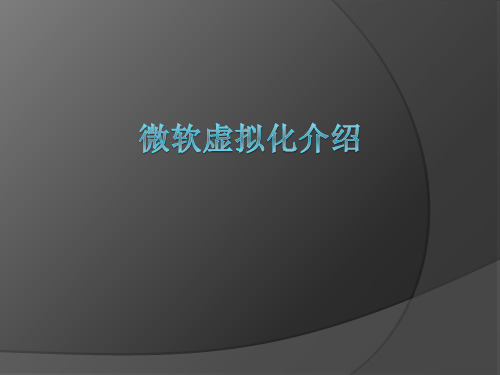
微软个人独享桌面虚拟化特点
用户将会独享一个VDI系统中的客户端虚拟机 客户端虚拟机完全模拟传统个人独享台式机/笔
记本的使用习惯
虚拟机中的客户端桌面环境基本OS由虚机模板创建 应用软件为虚机内手工/自动本地安装 用户的个人信息保存在虚拟机内部 用户拥有自己的客户端虚拟机名称
当承载虚机的宿主服务器宕机,其上的客户端 虚机可以快速在其他宿主服务器上进行恢复
将桌面环境以虚拟机的形式运行在服务器上 集中化管理,提高安全性 用户可以随时随地访问他的桌面环境
微软桌面虚拟化优势
加强办公桌面的标准化管理,减少出现问题的 次数
降低办公环境的宕机时间,改善服务用户体验 在IT环境不断提升中确保不兼容程序的继续服
务 严格把关办公应用的使用范围,确保办公信息
的安全 随时随地安全访问办公环境,提高办公效率 计算资源动态化,让桌面环境管理水平跃上新
机实例
当承载虚机的宿主服务器宕机,其上的客户端 虚机可以快速在其他宿主服务器上进行恢复
虚拟机出现严重问题使用对应的备份数据进行 恢复
微软应用程序虚拟化
DEM System Center
Operations Manager 2007
System Center Virtual App Server
平得不到显著提升
微软桌面虚拟体系化构成
文档重定向 离线文件
微软桌面虚拟化类别
基于服务器端虚拟化
基于客户端虚拟化
服务器端
客户端
客户端
VDI (Windows VECD – Windows Vista Enterprise Centralized Desktop), Terminal Services
计划
VMware虚拟化技术简介
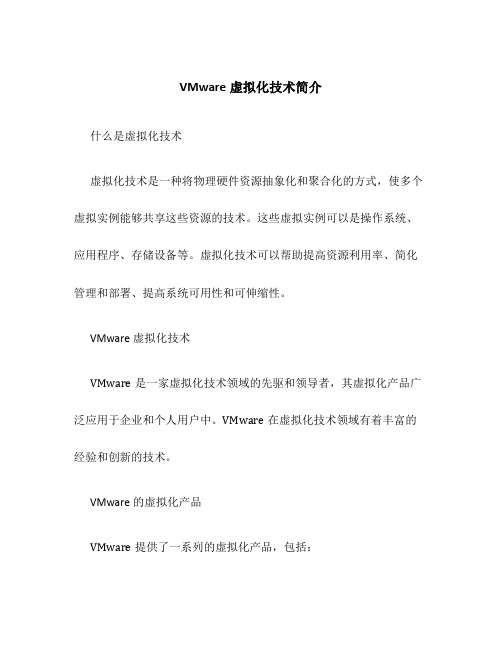
VMware虚拟化技术简介什么是虚拟化技术虚拟化技术是一种将物理硬件资源抽象化和聚合化的方式,使多个虚拟实例能够共享这些资源的技术。
这些虚拟实例可以是操作系统、应用程序、存储设备等。
虚拟化技术可以帮助提高资源利用率、简化管理和部署、提高系统可用性和可伸缩性。
VMware虚拟化技术VMware是一家虚拟化技术领域的先驱和领导者,其虚拟化产品广泛应用于企业和个人用户中。
VMware在虚拟化技术领域有着丰富的经验和创新的技术。
VMware的虚拟化产品VMware提供了一系列的虚拟化产品,包括:1.VMware ESXi:这是一种基于hypervisor的裸机虚拟化技术,可以直接运行在物理服务器硬件上,将物理服务器划分为多个虚拟机,并让它们共享物理资源。
2.VMware Workstation:这是一种桌面虚拟化软件,可以在一台物理电脑上同时运行多个虚拟操作系统实例,实现多操作系统的同时运行和测试。
3.VMware Fusion:这是一种专门为Mac用户设计的虚拟化软件,可以在Mac电脑上运行多个虚拟操作系统。
4.VMware Player:这是一种免费的桌面虚拟化软件,可以让用户在其个人电脑上运行虚拟机。
5.VMware vSphere:这是一种集成的虚拟化和云计算平台,提供了虚拟化、存储、网络和管理的综合解决方案,能够帮助企业构建自己的私有云环境。
VMware虚拟化技术的优势VMware的虚拟化技术具有许多优势,包括:1.资源利用率提高:通过虚拟化技术,可以将物理服务器的资源进行合理分配和利用,提高硬件资源的利用效率。
2.应用程序隔离:虚拟化技术能够将不同的应用程序运行在独立的虚拟机中,实现应用程序之间的隔离,提高系统的安全性和稳定性。
3.快速部署和迁移:虚拟化技术使得虚拟机可以在不同的物理服务器之间快速迁移,提高了系统的可伸缩性和可用性。
4.简化管理:通过虚拟化技术,可以将多个物理服务器集中管理,简化了系统的管理和维护工作。
虚拟化和VMware产品简介PPT课件

效率。
桌面虚拟化
使用Horizon View实现 远程访问和交付虚拟桌 面和应用程序,提高办
公效率。
云计算服务
VMware产品支持构建 和管理私有云环境,提 供灵活、高效的云计算
服务。
软件开发与测试
VMware产品为软件开 发和测试提供虚拟化环 境,加速软件开发生命
VMware产品与其他虚拟化产品的比较
与其他虚拟化产品相比, VMware的产品具有更高的性能
和可靠性。
VMware的产品提供了更全面的 虚拟化解决方案,包括服务器虚 拟化、存储虚拟化、网络虚拟化
和桌面虚拟化等。
VMware的产品还提供了更丰富 的特性和功能,如高可用性、容
错、安全性和可管理性等。
04
VMware产品的安装与配置
VMware产品的安装步骤
01
02
03
04
05
准备安装环境
下载安装包
安装VMware ES…
添加网络适配器 配置管理网络
确保服务器硬件符合 VMware的要求,准备足 够的存储空间和内存资源 。
从VMware官方网站下载 对应版本的安装包。
将下载的安装包烧录到启 动盘,启动服务器并进入 安装界面,按照提示完成 安装。
随着企业对于灵活性和效率的需 求增加,虚拟化技术将更加普及, 更多的企业将采用虚拟化技术来 简化IT管理,提高资源利用率。
混合云集成
虚拟化技术将与混合云集成更加 紧密,实现跨云平台的资源管理 和调度,以提供更加灵活和可扩
展的IT服务。
安全性增强
随着虚拟化技术的广泛应用,安 全性问题将更加受到关注,未来 的虚拟化技术将更加注重安全性
虚拟化:桌面虚拟化究竟指的是什么

虚拟化:桌面虚拟化究竟指的是什么虽然桌面虚拟化改变了用户的桌面应用传统,不过这种集中计算的方式让人感觉又回到了大型机的时代。
每个用户都可以保留他们的桌面操作系统和应用程序,但实际上这些实例都是运行在服务器的虚拟机上。
桌面虚拟化话让用户可以使用低成本的瘦客户端,而不必再使用传统的PC终端。
应用桌面虚拟化有很多的好处,支持的论据也常充分的:传统的桌面计算机要消耗大量的硬件资源,并且要面临更多的风险,每一台笔记本和台式机都有黑客而丢失数据的机会。
管理较为复杂,即使采用远程桌面管理,管理员在升级或者排错的时候都要把员工“”走,占用了员工工作的时间。
但是如果用户桌面仅仅是运行在服务器上的一个虚拟机,管理员就可以集中来管理用户,并安全。
集中管理也让打补丁等安全措施,以及硬件和软件升级更加方便,开销更少。
由于用户行为造成的错误和安全风险也能大大降低。
虽然采用桌面虚拟化能降低成本、让管理更加便捷、增加安全性,但反对桌面虚拟化的论调同样强烈。
通过集中管理带来的成本降低会被服务器、虚拟化软件费用、额外的网络带宽等费用抵消。
同时,客户端硬件以及微软软件许可证的费用大概还会持平。
此外,用户体验上,至少当前还不能满足用户的期望。
更加重要的是,一旦网络断开,用户将如何来工作?所以在采用桌面虚拟化之前需要仔细的考量,是否要应用,或者采用哪种形式。
下面有一些桌面虚拟化的基本知识,在利用桌面虚拟化前都是应该知道的:1、桌面虚拟化是“真正的”虚拟化就像服务器虚拟化,桌面虚拟化依靠一个很薄的软件层hypervisor。
hypervisor直接运行在计算机物理硬件之上,为管理员提供一个部署和管理虚拟机的平台。
采用桌面虚拟化的时候,每个用户获得一个虚拟机,里面包含的桌面操作系统,用户同样可以安装各种应用软件,用户就好像在应用一个真正的桌面计算机一样。
2、传统的瘦客户端解决方案并不是桌面虚拟化到目前为止,最流行的基于服务器、瘦客户端的计算方式是依赖于微软的终端服务(现在叫作远程桌面服务),让多个用户共享同一个Windows实例。
VMware服务器虚拟化概念-好处-功能-案例-桌面虚拟化简介

VMware 服务器虚拟化
业务连接性之DRS功能
动态负载均衡和连续智能优化,保证所有应用需要的的资源
•功能 – 跨资源池动态调整计算资源 – 基于预定义的规则智能分配资源
业务需求
资源池
•优势 – 使IT和业务优先级对应 – 动态提高系统管理效率 – 自动化的硬件维护
围绕业务进行组织和规划…而不是您的硬件!
VMware 服务器虚拟化
业务连接性之StorageVMotion功能
应用程序 应用程序
应用程序 操作 系统 操作 系统 操作 系统
– 虚拟机磁盘存储独立迁移
• 无需虚拟机停机 • LUN 独立 • 支持光纤通道 SAN
无中断:
刷新到新阵列 迁移到不同类别的存储器 升级到新文件系统格式 虚拟机粒度,LUN 独立
安全之VMware VMsafe
– API 通过检查与管理程序一起使用 的虚拟组件来保护虚拟机 – 将保护引擎与恶意软件隔离 – 广泛的覆盖范围,包括虚拟机 CPU 、内存、存储器和网络
应用程序
操作系统 保护引擎
VMware vSphere™
VMware 服务器虚拟化
安全之VMware vShield
…改造成这样简捷的配置
没有利用VMware软件之前的10-20台服务器
使用VMware软件后,整合成2-4台服务器、一个机架
VMware 服务器虚拟化
虚拟化好处之节约机房空间
实现虚拟化之前
实施虚拟化之后
服务器 存储 网络 设施
– 20
– 直连 – 100 网络端口 – 80U机架 – 40电缆线
依赖硬件可用性 易发生人为错误 标准化困难 审核困难 需要数天,甚至数周
- 1、下载文档前请自行甄别文档内容的完整性,平台不提供额外的编辑、内容补充、找答案等附加服务。
- 2、"仅部分预览"的文档,不可在线预览部分如存在完整性等问题,可反馈申请退款(可完整预览的文档不适用该条件!)。
- 3、如文档侵犯您的权益,请联系客服反馈,我们会尽快为您处理(人工客服工作时间:9:00-18:30)。
微软与VMWARE的桌面虚拟化简介rickyfang2009-03-10一、VDI作用简要说明对VDI更多的理解和作用还是请用GOOGLE吧。
或是去微软或VMWARE的官方站点。
1、通过 Virtual Desktop Infrastructure,企业可以使用虚拟化技术在数据中心以虚拟机形式托管桌面。
2、用户可以使用远程显示协议从 PC 或瘦客户端进行访问。
二、理解微软的桌面虚拟化解决方案微软的桌面虚拟化主要有两个方面:1、Client-hosted类型的:以Virtual pc 2007为基础。
辅助于MED-V(Microsoft Enterprise Desktop Virtualization)。
而MED-V目前还在初期阶段,据我所知的版本是V1.0。
A、MED-V environment(包含的组件,就不译成中文了,很简单的):Host The end user’s physical computer, typi cally a desktop or laptop computer. It’salso called an endpoint computer.MED-V Client Software that runs on the host that can download and run Virtual PCimages seamlessly on the host, according to MED-V usage policies.MED-V Image Repository An IIS Web server that stores and distributes virtual imagesto endpoints.MED-V Management Server A MED-V server that authenticates, provisions, and controls all users of the system. Client-server communication is based on HTTP orHTTPS.MED-V Server The server that holds the main image repository and is the management server.MED-V Package A mechanism for installing Virtual PC, the MED-V client, and optionally a virtual image on a host.Workspace The Virtual PC image that the MED-V client runs on the ho st. It’s alsocalled a virtual machine or guest.B、对Virtual PC 2007增强的支持:Virtual images repository and delivery虚拟镜像存储和分发 Simplifi es the process of creating, testing,delivering, and updating virtual images。
Centralized management and monitoring集中的管理和监视 Manages the life cycle of virtual images,provisions virtual images to authenticated users according to Microsoft Active Directory users and groups, and aggregates client events for monitoring and reporting purposes。
User policy and data transfer control 用户策略和数据传输 An endpoint agent enforces usage policies and data transfer permissions on the virtual machine。
Seamless end-user experience无缝的最终用户体验 The user remains unaware of the virtualizationrunning in the background and keeps one desktop environment。
2、Server-Based类型的:以Hyperv-V为基础,使用VMM2008作为管理中心。
此图就是典型的MS的VDI虚拟桌面基础架构解决方案的拓朴。
可以和接下来VMWARE作一些对比。
但目前应用较少,老方还没有发现在企业中的成功应用。
如果有此经验者,请交流下。
老方也会在较有精力时为大家奉上使用体验的系列文章,敬请观注。
三、理解VMWARE的桌面虚拟化解决方案VMWARE的桌面虚拟化也主要有两个方面:1、Client-hosted类型的:VMware Workstation 系列版本,实际上,老方如果不是怕VMWARE不答应也想把VMware Server给归置到此类。
不过严格来说应属于服务器虚拟化范畴啦。
此软件,相信大多数朋友都有使用过的经历。
此处免去介绍。
2、VMware VDI解决方案(VIEW 3.0)VMWARE的VDI解决方案在企业中应用较为广泛:像在呼叫中心、集中访问等。
通过上述的拓朴大家就可以清楚典型的VMWARE的VIEW解决方案:客户端(连接客户端)——VDM (连接服务器)——VC——ESX SERVER。
当然也可以去掉VC集中管理直接连接ESX。
更直白的说就是VDM CLEINT +VDM CONNECT SERVER +VI3构成了VMWARE的虚拟桌面解决方案。
桌面池、动态池、静态池、是否分配固定桌面均是通过VDM Connect server 来进行的。
总之,它提供了丰富的管理功能以及两种VDM类型(网关或仅代理型)。
以上,只是简要说明了下,以使大家有个入门的了解。
更详细的功能或架构还请参考官方文档。
老方诚意为大家多交流关于虚拟化方面的技术及解决方案,以使在交流中进步。
HP远程办公-VDI虚拟化解决方案rickyfang2009-02-20方案技术要点采用VDI虚拟化解决方案构建一个基于服务器的桌面系统解决方案,是应对PC桌面挑战、优化资源和管理以及灵活控制总拥有成本的有效方法。
采用虚拟桌面架构可以保留完整的桌面计算环境,运行在VMware ESX服务器上面的虚拟PC上面包含了操作系统、应用软件和各种配置。
系统管理员使用VMware VirtualCenter 集中管理所有运行在ESX服务器上面的虚拟PC。
最终用户使用PC机或瘦客户机,通过远程桌面显示软件访问和使用他们的企业桌面系统。
VDI虚拟化解决方案组成部分硬件:刀片或机架式服务器提供计算资源Blade瘦客户机作为用户访问的终端设备软件:1.VMware ESX服务器上面运行包含所有桌面运行环境的虚拟PC2.VMware VirtualCenter服务器管理ESX服务器以及运行在其上的所有虚拟机3.第三方远程显示软件产品将用户终端和虚拟桌面环境连接起来(如Windows XP内的,采用RDP远程显示协议的的远程控制台)采用虚拟桌面机构之后,系统管理员可以:4.构建与硬件独立的桌面环境5.在同一个系统上同时运行多个虚拟PC机,这些PC机彼此之间完全隔离、互不影响。
6.可以在几分钟之内就可以从模版中部署新的虚拟PC7.无论最终用户在哪里,是否在使用虚拟桌面。
管理员都可以对整个PC系统实施统一的管理和维护操作,例如安装软件、打补丁、备份数据、设置安全策略等。
方案突出特点提高了桌面系统的可管理性,VDI虚拟化解决方案使得集中管理和部署桌面环境成为可能,包括配置、资源以及负载管理等。
快速部署桌面系统,桌面系统管理员可以独立于硬件部署虚拟机。
通过使用预先准备好的虚拟机模版,管理员可以在几分钟之内就部署众多桌面环境,使得很多部署过程自动化。
增强了桌面系统的灵活性,用户可以通过单一的终端设备访问多个桌面环境。
他们可以通过任意的、连接到系统网络上的终端设备访问他们的桌面环境。
系统管理员可以迅速将不活动的桌面环境归档或删除,将其所占用的资源释放共其它桌面系统使用。
提高桌面系统的数据保护能力,统管理员可以采用数据中心已有的数据备份系统对所有桌面环境进行统一、可靠的备份。
由于虚拟机完全独立于硬件环境,使得桌面系统的恢复操作变得十分简单、迅速。
数据的安全也得到了极大的改善,因为所有数据都集中存储在数据中心。
更好地资源利用效率,在一台服务器上运行多个桌面环境使用户可以提高硬件资源利用效率,因为可以为虚拟机动态调配和重新使用计算资源。
降低成本,通过将桌面环境集中并将桌面硬件标准化,虚拟桌面架构使得企业用户极大地降低了管理众多桌面系统的难度和复杂程度,从而降低了整个企业桌面系统的拥有成。
通过采用VDI虚拟化解决方案构成的、基于服务器的桌面系统解决方案,企业用户找到了一个可替代传统桌面系统的方法,使企业可以大大提高对整个桌面系统的管理能力、降低总拥有成本、提高资源利用率、更简便和可靠地保护关键数据。
虚拟化技术对作操作系统的改变彪哥来了2009-02-17随着IT技术的整体创新和推动,虚拟化已经开始通过服务器平台和操作系统平台对企业的IT核心基础架构产生巨大冲击。
近两年来,虚拟化技术不断成熟、产品应用的范围逐步扩宽,国内用户通过VMware、微软等厂商的产品逐步了解了虚拟化,并且通过IBM、微软、Google等所倡导的“云计算”对虚拟化技术有了更为深入的认知。
与此同时,随着IT技术的整体创新和推动,虚拟化已经开始通过服务器平台和操作系统平台对企业的IT核心基础架构产生巨大冲击。
这种冲击主要表现在两个层面:首先,用户对操作系统的需求没有出现明显的增长或者新的需求变化,因此这一市场需要新的增长点,这为厂商提出技术驱动提供了基础环境。
前两年增速最快的Linux市场,近来市场增速也有所放缓。
在市场并未出现用户向Linux大规模迁移的形势下,收入压力和竞争环境迫使多数专一提供Linux操作系统的厂商退出市场,比如,即时、冲浪、共创开源、拓林思等先后退出了这一市场或逐步转型。
事实上,1.5亿元的市场规模不可能容纳超过4家的竞争者并且它们都能获得满意的回报,在Linux成长初期的现阶段,对于操作系统厂商而言,投入是要大于回报的,这就使得并不是所有厂商都能坚持到最后。
